

|
Restored revision 1039633856 by Ballinacurra Weston (talk)
|
|||
| Line 21: | Line 21: | ||
This is a '''list of the 61 cases reported in volume 60 (19 How.) of ''[[United States Reports]]''''', decided by the [[Supreme Court of the United States]] from December 1856 to March 1857.<ref>Anne Ashmore, ''DATES OF SUPREME COURT DECISIONS AND ARGUMENTS'', Library, Supreme Court of the United States, 26 December 2018.</ref> |
This is a '''list of the 61 cases reported in volume 60 (19 How.) of ''[[United States Reports]]''''', decided by the [[Supreme Court of the United States]] from December 1856 to March 1857.<ref>Anne Ashmore, ''DATES OF SUPREME COURT DECISIONS AND ARGUMENTS'', Library, Supreme Court of the United States, 26 December 2018.</ref> |
||
== Nominative reports == |
== Nominative reports == |
||
In 1874, the U.S. government created the ''United States Reports'', and retroactively numbered older privately-published [[Law report|case reports]] as part of the new series. As a result, cases appearing in volumes 1–90 of ''U.S. Reports'' have dual [[Case citation|citation forms]]; one for the volume number of ''U.S. Reports'', and one for the volume number of the reports named for the relevant reporter of decisions (these are called |
In 1874, the U.S. government created the ''United States Reports'', and retroactively numbered older privately-published [[Law report|case reports]] as part of the new series. As a result, cases appearing in volumes 1–90 of ''U.S. Reports'' have dual [[Case citation|citation forms]]; one for the volume number of ''U.S. Reports'', and one for the volume number of the reports named for the relevant reporter of decisions (these are called ”[[Nominate reports|nominative reports]]”). |
||
=== Benjamin Chew Howard === |
=== Benjamin Chew Howard === |
||
Starting with the 42nd volume of ''U.S. Reports'', the [[Reporter of Decisions of the Supreme Court of the United States]] was [[Benjamin Chew Howard]]. Howard was Reporter of Decisions from 1843 to 1860, covering volumes 42 through 65 of ''United States Reports'' which correspond to volumes 1 through 24 of his '' |
Starting with the 42nd volume of ''U.S. Reports'', the [[Reporter of Decisions of the Supreme Court of the United States]] was [[Benjamin Chew Howard]]. Howard was Reporter of Decisions from 1843 to 1860, covering volumes 42 through 65 of ''United States Reports'' which correspond to volumes 1 through 24 of his ''Howard’s Reports''. As such, the dual form of citation to, for example, ''Lathrop v. Judson'' is 60 U.S. (19 How.) 66 (1857). |
||
== Justices of the Supreme Court at the time of 60 U.S. (19 How.) == |
== Justices of the Supreme Court at the time of 60 U.S. (19 How.) == |
||
| Line 29: | Line 29: | ||
{{see also|List of justices of the Supreme Court of the United States by court composition}} |
{{see also|List of justices of the Supreme Court of the United States by court composition}} |
||
{{see also|Taney Court}} |
{{see also|Taney Court}} |
||
The Supreme Court is established by [[Article Three of the United States Constitution|Article III, Section 1]] of the [[Constitution of the United States]], which says: |
The Supreme Court is established by [[Article Three of the United States Constitution|Article III, Section 1]] of the [[Constitution of the United States]], which says: ”The judicial Power of the United States, shall be vested in one supreme Court . . .”. The size of the Court is not specified; the Constitution leaves it to [[Congress of the United States|Congress]] to set the number of justices. Under the [[Judiciary Act of 1789]] Congress originally fixed the number of justices at six (one chief justice and five associate justices).<ref>{{cite web|url=https://guides.ll.georgetown.edu/supreme_court|title=Supreme Court Research Guide |access-date=7 April 2021 |publisher=Georgetown Law Library}}</ref> Since 1789 Congress has varied the size of the Court from six to [[Seventh Circuit Act of 1807|seven]], [[Eighth and Ninth Circuits Act of 1837|nine]], [[Tenth Circuit Act of 1863|ten]], and back to [[Judiciary Act of 1869|nine]] justices (always including one chief justice). When the cases in 60 U.S. (19 How.) were decided the Court comprised these nine members: |
||
{| class="wikitable sortable" |
{| class="wikitable sortable" |
||
|- |
|- |
||
| Line 91: | Line 91: | ||
}} |
}} |
||
===''Scott v. Sanford''=== |
===''Scott v. Sanford''=== |
||
''[[Scott v. Sandford]]'', [https://www.courtlistener.com/opinion/87116/dred-scott-v-sandford/?q=%2260%20U.S.%20393%22&type=o&order_by=score%20desc&stat_Precedential=on&filed_after=01%2F01%2F1856&filed_before=01%2F01%2F1858&court=scotus 60 U.S. (19 How.) 393 (1857)], is likely the most notorious and widely-condemned decision in the history of the US Supreme Court. In it, the Court held that the [[US Constitution]] was not meant to include [[American citizenship]] for [[black people]], regardless of whether they were enslaved or free, and so the rights and privileges that the Constitution confers upon American citizens could not apply to them. Although Chief Justice [[Roger Taney]] and several of the other justices hoped that the decision would permanently settle the slavery controversy, which was increasingly dividing the American public, the |
''[[Scott v. Sandford]]'', [https://www.courtlistener.com/opinion/87116/dred-scott-v-sandford/?q=%2260%20U.S.%20393%22&type=o&order_by=score%20desc&stat_Precedential=on&filed_after=01%2F01%2F1856&filed_before=01%2F01%2F1858&court=scotus 60 U.S. (19 How.) 393 (1857)], is likely the most notorious and widely-condemned decision in the history of the US Supreme Court. In it, the Court held that the [[US Constitution]] was not meant to include [[American citizenship]] for [[black people]], regardless of whether they were enslaved or free, and so the rights and privileges that the Constitution confers upon American citizens could not apply to them. Although Chief Justice [[Roger Taney]] and several of the other justices hoped that the decision would permanently settle the slavery controversy, which was increasingly dividing the American public, the decision’s effect was the opposite. Taney’s majority opinion suited the slaveholding states, but was intensely decried in the other states. The decision inflamed the national debate over slavery and deepened the divide that led ultimately to the [[American Civil War|Civil War]]. In 1865, after the Union won the Civil War, the ''Dred Scott'' ruling was voided by the [[Thirteenth Amendment to the United States Constitution|Thirteenth Amendment]] to the US Constitution, which abolished slavery except as punishment for a crime, and the [[Fourteenth Amendment to the United States Constitution|Fourteenth Amendment]], which guaranteed citizenship for ”all persons born or naturalized in the United States, and subject to the jurisdiction thereof”. The Supreme Court's decision has been continuously denounced ever since, both for its overt racism and its role in the near destruction of the [[United States]] four years later.<ref>{{cite web |title= |
||
Ranking the 10 Worst Supreme Court Decisions of All-Time |url=https://moneyinc.com/worst-supreme-court-decisions/ |first=Garrett |last=Parker |publisher=[[Money Inc.]] |year=2019 |access-date=June 10, 2021}}</ref><ref>{{cite web |title=13 Worst Supreme Court Decisions of All Time |url=https://blogs.findlaw.com/supreme_court/2015/10/13-worst-supreme-court-decisions-of-all-time.html |author=Staff |publisher=[[FindLaw]] |date=October 14, 2015 |access-date=June 10, 2021}}</ref> Bernard Schwartz said that it |
Ranking the 10 Worst Supreme Court Decisions of All-Time |url=https://moneyinc.com/worst-supreme-court-decisions/ |first=Garrett |last=Parker |publisher=[[Money Inc.]] |year=2019 |access-date=June 10, 2021}}</ref><ref>{{cite web |title=13 Worst Supreme Court Decisions of All Time |url=https://blogs.findlaw.com/supreme_court/2015/10/13-worst-supreme-court-decisions-of-all-time.html |author=Staff |publisher=[[FindLaw]] |date=October 14, 2015 |access-date=June 10, 2021}}</ref> Bernard Schwartz said that it ”stands first in any list of the worst Supreme Court decisions—Chief Justice [[Charles Evans Hughes|Hughes]] called it the Court's greatest self-inflicted wound”.<ref>{{cite book |author=Bernard Schwartz |title=A Book of Legal Lists: The Best and Worst in American Law |url=https://archive.org/details/bookoflegallists0000schw |url-access=registration |year=1997 |publisher=[[Oxford University Press]] |page=[https://archive.org/details/bookoflegallists0000schw/page/70 70]}}</ref> [[Junius P. Rodriguez]] wrote that it is ”universally condemned as the U.S. Supreme Court's worst decision”.<ref>{{cite book |author=Junius P. Rodriguez |title=Slavery in the United States: A Social, Political, and Historical Encyclopedia |url=https://books.google.com/books?id=4X44KbDBl9gC&pg=RA1-PA265 |year=2007 |publisher=ABC-CLIO |page=1|isbn=9781851095445 }}</ref> Historian David Thomas Konig agrees that it was ”unquestionably, our court's worst decision ever”.<ref>{{cite book |author=David Konig |title=The Dred Scott Case: Historical and Contemporary Perspectives on Race and Law |url=https://books.google.com/books?id=KFOD1NwZtWUC&pg=PA213 |year=2010 |publisher=Ohio University Press |page=213 |isbn=9780821419120 |display-authors=etal}}</ref> |
||
== Citation style == |
== Citation style == |
||
| Line 101: | Line 101: | ||
[[Bluebook]] citation style is used for case names, citations, and jurisdictions. |
[[Bluebook]] citation style is used for case names, citations, and jurisdictions. |
||
* |
* ”C.C.D.” = United States Circuit Court for the District of . . . |
||
** ''e.g.,'' |
** ''e.g.,''”C.C.D.N.J.” = United States Circuit Court for the District of New Jersey |
||
* |
* ”D.” = United States District Court for the District of . . . |
||
** ''e.g.,'' |
** ''e.g.,''”D. Mass.” = [[United States District Court for the District of Massachusetts]] |
||
* |
* ”E.” = Eastern; ”M.” = Middle; ”N.” = Northern; ”S.” = Southern; ”W.” = Western |
||
** ''e.g.,'' |
** ''e.g.,''”C.C.S.D.N.Y.” = United States Circuit Court for the Southern District of New York |
||
** ''e.g.,'' |
** ''e.g.,''”M.D. Ala.” = [[United States District Court for the Middle District of Alabama]] |
||
* |
* ”Adm.” = [[Admiralty Court]] (a federal court) |
||
* |
* ”Ct. Cl.” = [[United States Court of Claims]] |
||
* |
* ”C.P.” = [[Court of Common Pleas]] (a state court) |
||
* The abbreviation of a state's name alone indicates the highest appellate court in that |
* The abbreviation of a state's name alone indicates the highest appellate court in that state’s judiciary at the time. |
||
** ''e.g.,'' |
** ''e.g.,''”Pa.” = [[Supreme Court of Pennsylvania]] |
||
** ''e.g.,'' |
** ''e.g.,''”Me.” = [[Supreme Judicial Court of Maine]] |
||
== List of cases in 60 U.S. (19 How.) == |
== List of cases in 60 U.S. (19 How.) == |
||
{| class="wikitable sortable" |
{| class="wikitable sortable" |
||
|- |
|- |
||
! scope="col" style="width: |
! scope="col" style="width: 350px;" | Case Name |
||
! scope="col" style="width: 75px;" | Page & year |
! scope="col" style="width: 75px;" | Page & year |
||
! scope="col" style="width: 10px;" | Opinion of the Court |
! scope="col" style="width: 10px;" | Opinion of the Court |
||
! scope="col" style="width: |
! scope="col" style="width: 100px;" | Concurring opinion(s) |
||
! scope="col" style="width: |
! scope="col" style="width: 116px;" | Dissenting opinion(s) |
||
! scope="col" style="width: |
! scope="col" style="width: 133px;" | Lower court |
||
! scope="col" style="width: |
! scope="col" style="width: 250px;" | Disposition of case |
||
|- |
|- |
||
| ''Prevost v. Greneaux'' |
| ''Prevost v. Greneaux'' |
||
| Line 262: | Line 262: | ||
| affirmed |
| affirmed |
||
|- |
|- |
||
| ''Long v. |
| ''Long v. O’Fallon'' |
||
| align="right"|[https://www.courtlistener.com/opinion/87074/long-v-ofallon/?q=%2260%20U.S.%20116%20%22&type=o&order_by=score%20desc&stat_Precedential=on&filed_after=01%2F01%2F1856&filed_before=01%2F01%2F1858&court=scotus 116 (1856)] |
| align="right"|[https://www.courtlistener.com/opinion/87074/long-v-ofallon/?q=%2260%20U.S.%20116%20%22&type=o&order_by=score%20desc&stat_Precedential=on&filed_after=01%2F01%2F1856&filed_before=01%2F01%2F1858&court=scotus 116 (1856)] |
||
| Campbell |
| Campbell |
||
| Line 358: | Line 358: | ||
| affirmed |
| affirmed |
||
|- |
|- |
||
| '' |
| ''N.Y. & Va. S.S. Co. v. Calderwood'' |
||
| align="right"|[https://www.courtlistener.com/opinion/87086/new-york-and-virginia-steamship-v-ezra-calderwood/?q=%2260%20U.S.%20241%20%22&type=o&order_by=score%20desc&stat_Precedential=on&filed_after=01%2F01%2F1856&filed_before=01%2F01%2F1858&court=scotus 241 (1857)] |
| align="right"|[https://www.courtlistener.com/opinion/87086/new-york-and-virginia-steamship-v-ezra-calderwood/?q=%2260%20U.S.%20241%20%22&type=o&order_by=score%20desc&stat_Precedential=on&filed_after=01%2F01%2F1856&filed_before=01%2F01%2F1858&court=scotus 241 (1857)] |
||
| Campbell |
| Campbell |
||
| Line 438: | Line 438: | ||
| affirmed |
| affirmed |
||
|- |
|- |
||
| ''Garrison v. Memphis |
| ''Garrison v. Memphis Ins. Co.'' |
||
| align="right"|[https://www.courtlistener.com/opinion/87096/garrison-v-memphis-insurance-company/?q=%2260+U.S.%22&type=o&order_by=dateFiled+asc&stat_Precedential=on&filed_after=01%2F01%2F1856&filed_before=01%2F01%2F1858&court=scotus&page=3 312 (1857)] |
| align="right"|[https://www.courtlistener.com/opinion/87096/garrison-v-memphis-insurance-company/?q=%2260+U.S.%22&type=o&order_by=dateFiled+asc&stat_Precedential=on&filed_after=01%2F01%2F1856&filed_before=01%2F01%2F1858&court=scotus&page=3 312 (1857)] |
||
| Campbell |
| Campbell |
||
| Line 446: | Line 446: | ||
| affirmed |
| affirmed |
||
|- |
|- |
||
| ''Commercial |
| ''Commercial Mut. Marine Ins. v. Union Mut. Ins.'' |
||
| align="right"|[https://www.courtlistener.com/opinion/87097/commercial-mut-marine-ins-co-v-union-mut-ins-co-of-ny/?q=%2260%20U.S.318%22&type=o&order_by=dateFiled%20asc&stat_Precedential=on&filed_after=01%2F01%2F1856&filed_before=01%2F01%2F1858&court=scotus 318 (1857)] |
| align="right"|[https://www.courtlistener.com/opinion/87097/commercial-mut-marine-ins-co-v-union-mut-ins-co-of-ny/?q=%2260%20U.S.318%22&type=o&order_by=dateFiled%20asc&stat_Precedential=on&filed_after=01%2F01%2F1856&filed_before=01%2F01%2F1858&court=scotus 318 (1857)] |
||
| Curtis |
| Curtis |
||
| Line 558: | Line 558: | ||
| affirmed |
| affirmed |
||
|- |
|- |
||
| ''[[Michigan Central Railroad|Michigan |
| ''[[Michigan Central Railroad|Michigan Cent. R.R. Co.]] v. [[Lake Shore and Michigan Southern Railway|Michigan S.R.R. Co.]]'' |
||
| align="right"|[https://www.courtlistener.com/opinion/87110/michigan-central-railroad-co-v-mich-s-rd-co/?q=%2260+U.S.%22&type=o&order_by=dateFiled+asc&stat_Precedential=on&filed_after=01%2F01%2F1856&filed_before=01%2F01%2F1858&court=scotus&page=3 378 (1857)] |
| align="right"|[https://www.courtlistener.com/opinion/87110/michigan-central-railroad-co-v-mich-s-rd-co/?q=%2260+U.S.%22&type=o&order_by=dateFiled+asc&stat_Precedential=on&filed_after=01%2F01%2F1856&filed_before=01%2F01%2F1858&court=scotus&page=3 378 (1857)] |
||
| Grier |
| Grier |
||
| Supreme Court of the United States | |
|---|---|
 | |
 | |
| 38°53′26″N 77°00′16″W / 38.89056°N 77.00444°W / 38.89056; -77.00444 | |
| Established | March 4, 1789; 235 years ago (1789-03-04)[1] |
| Location | Washington, D.C. |
| Coordinates | 38°53′26″N 77°00′16″W / 38.89056°N 77.00444°W / 38.89056; -77.00444 |
| Composition method | Presidential nomination with Senate confirmation |
| Authorized by | Constitution of the United States |
| Judge term length | Life tenure |
| Number of positions | 9 (by statute) |
| Website | supremecourt |
| Chief Justice of the United States | |
| Currently | John Roberts |
| Since | September 29, 2005; 18 years ago (2005-09-29) |
| This article is part of a series on the |
| Supreme Court of the United States |
|---|
 |
| The Court |
| Current membership |
|
| Lists of justices |
|
| Court functionaries |
|
|
This is a list of the 61 cases reported in volume 60 (19 How.) of United States Reports, decided by the Supreme Court of the United States from December 1856 to March 1857.[2]
In 1874, the U.S. government created the United States Reports, and retroactively numbered older privately-published case reports as part of the new series. As a result, cases appearing in volumes 1–90 of U.S. Reports have dual citation forms; one for the volume number of U.S. Reports, and one for the volume number of the reports named for the relevant reporter of decisions (these are called ”nominative reports”).
Starting with the 42nd volume of U.S. Reports, the Reporter of Decisions of the Supreme Court of the United States was Benjamin Chew Howard. Howard was Reporter of Decisions from 1843 to 1860, covering volumes 42 through 65 of United States Reports which correspond to volumes 1 through 24 of his Howard’s Reports. As such, the dual form of citation to, for example, Lathrop v. Judson is 60 U.S. (19 How.) 66 (1857).
The Supreme Court is established by Article III, Section 1 of the Constitution of the United States, which says: ”The judicial Power of the United States, shall be vested in one supreme Court . . .”. The size of the Court is not specified; the Constitution leaves it to Congress to set the number of justices. Under the Judiciary Act of 1789 Congress originally fixed the number of justices at six (one chief justice and five associate justices).[3] Since 1789 Congress has varied the size of the Court from six to seven, nine, ten, and back to nine justices (always including one chief justice). When the cases in 60 U.S. (19 How.) were decided the Court comprised these nine members:
| Portrait | Justice | Office | Home State | Succeeded | Date confirmed by the Senate (Vote) |
Tenure on Supreme Court |
|---|---|---|---|---|---|---|
 |
Roger B. Taney | Chief Justice | Maryland | John Marshall | March 15, 1836 (29–15) |
March 28, 1836 – October 12, 1864 (Died) |
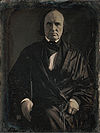 |
John McLean | Associate Justice | Ohio | Robert Trimble | March 7, 1829 (Acclamation) |
January 11, 1830 – April 4, 1861 (Died) |
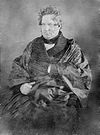 |
James Moore Wayne | Associate Justice | Georgia | William Johnson | January 9, 1835 (Acclamation) |
January 14, 1835 – July 5, 1867 (Died) |
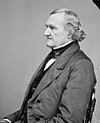 |
John Catron | Associate Justice | Tennessee | newly-created seat | March 8, 1837 (28–15) |
May 1, 1837 – May 30, 1865 (Died) |
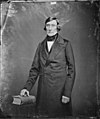 |
Peter Vivian Daniel | Associate Justice | Virginia | Philip P. Barbour | March 2, 1841 (25–5) |
January 10, 1842 – May 31, 1860 (Died) |
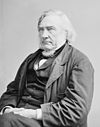 |
Samuel Nelson | Associate Justice | New York | Smith Thompson | February 14, 1845 (Acclamation) |
February 27, 1845 – November 28, 1872 (Retired) |
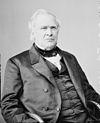 |
Robert Cooper Grier | Associate Justice | Pennsylvania | Henry Baldwin | August 4, 1846 (Acclamation) |
August 10, 1846 – January 31, 1870 (Retired) |
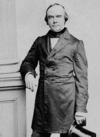 |
Benjamin Robbins Curtis | Associate Justice | Massachusetts | December 20, 1851 (Acclamation) |
October 10, 1851 – September 30, 1857 (Resigned) | |
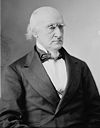
|
John Archibald Campbell | Associate Justice | Alabama | John McKinley | March 22, 1853 (Acclamation) |
April 11, 1853 – April 30, 1861 (Resigned) |
Scott v. Sandford, 60 U.S. (19 How.) 393 (1857), is likely the most notorious and widely-condemned decision in the history of the US Supreme Court. In it, the Court held that the US Constitution was not meant to include American citizenship for black people, regardless of whether they were enslaved or free, and so the rights and privileges that the Constitution confers upon American citizens could not apply to them. Although Chief Justice Roger Taney and several of the other justices hoped that the decision would permanently settle the slavery controversy, which was increasingly dividing the American public, the decision’s effect was the opposite. Taney’s majority opinion suited the slaveholding states, but was intensely decried in the other states. The decision inflamed the national debate over slavery and deepened the divide that led ultimately to the Civil War. In 1865, after the Union won the Civil War, the Dred Scott ruling was voided by the Thirteenth Amendment to the US Constitution, which abolished slavery except as punishment for a crime, and the Fourteenth Amendment, which guaranteed citizenship for ”all persons born or naturalized in the United States, and subject to the jurisdiction thereof”. The Supreme Court's decision has been continuously denounced ever since, both for its overt racism and its role in the near destruction of the United States four years later.[4][5] Bernard Schwartz said that it ”stands first in any list of the worst Supreme Court decisions—Chief Justice Hughes called it the Court's greatest self-inflicted wound”.[6] Junius P. Rodriguez wrote that it is ”universally condemned as the U.S. Supreme Court's worst decision”.[7] Historian David Thomas Konig agrees that it was ”unquestionably, our court's worst decision ever”.[8]
Under the Judiciary Act of 1789 the federal court structure at the time comprised District Courts, which had general trial jurisdiction; Circuit Courts, which had mixed trial and appellate (from the US District Courts) jurisdiction; and the United States Supreme Court, which had appellate jurisdiction over the federal District and Circuit courts—and for certain issues over state courts. The Supreme Court also had limited original jurisdiction (i.e., in which cases could be filed directly with the Supreme Court without first having been heard by a lower federal or state court). There were one or more federal District Courts and/or Circuit Courts in each state, territory, or other geographical region.
Bluebook citation style is used for case names, citations, and jurisdictions.
| Case Name | Page & year | Opinion of the Court | Concurring opinion(s) | Dissenting opinion(s) | Lower court | Disposition of case |
|---|---|---|---|---|---|---|
| Prevost v. Greneaux | 1 (1857) | Taney | none | none | La. | affirmed |
| Morgan v. Curtenius | 8 (1857) | Taney | none | none | C.C.D. Ill. | continued |
| Ex parte Secombe | 9 (1857) | Taney | none | none | Sup. Ct. Terr. Minn. | mandamus denied |
| Shaffer v. Scudday | 16 (1857) | Taney | none | none | La. | dismissed for want of jurisdiction |
| Thomas v. Osborn | 22 (1856) | Curtis | none | Taney | C.C.D. Md. | remanded for dismissal |
| Ure v. Coffman | 56 (1857) | Wayne | none | none | C.C.E.D. La. | affirmed |
| Stevens v. Gladding | 64 (1857) | McLean | none | none | C.C.D.R.I. | affirmed |
| Lathrop v. Judson | 66 (1857) | McLean | none | none | C.C.E.D. La. | affirmed |
| Moore v. Greene | 69 (1856) | McLean | none | none | C.C.D.R.I. | affirmed |
| Betts v. Lewis | 72 (1857) | Curtis | none | none | N.D. Ala. | remanded to amend pleadings |
| United States v. le Baron | 73 (1856) | Curtis | none | none | C.C.S.D. Ala. | reversed |
| Willot v. Sandford | 79 (1856) | Catron | none | none | C.C.D. Mo. | reversed |
| Vandewater v. Mills | 82 (1857) | Grier | none | none | C.C.D. Cal. | affirmed |
| The Brig Neurea | 92 (1856) | Grier | none | none | N.D. Cal. | reversed |
| Seymour v. McCormick | 96 (1857) | Nelson | none | none | C.C.N.D.N.Y. | affirmed |
| The Steamer St. Charles | 108 (1857) | Nelson | none | none | C.C.E.D. La. | reversed |
| Coiron v. Millaudon | 113 (1857) | Nelson | none | none | C.C.E.D. La. | affirmed |
| Long v. O’Fallon | 116 (1856) | Campbell | none | none | C.C.D. Mo. | affirmed |
| Baker v. Nachtrieb | 126 (1856) | Campbell | none | none | C.C.W.D. Pa. | reversed |
| Meegan v. Boyle | 130 (1857) | McLean | none | none | C.C.D. Mo. | affirmed |
| Post v. Jones | 150 (1857) | Grier | none | none | C.C.S.D.N.Y. | reversed |
| E.I. Dupont de Nemours Co. v. Vance | 162 (1857) | Curtis | none | Campbell | C.C.E.D. La. | reversed |
| The Steamer Virginia | 182 (1857) | Taney | none | none | C.C.D. Md. | dismissed |
| Brown v. Duchesne | 183 (1857) | Taney | none | none | C.C.D. Mass. | affirmed |
| Mordecai v. Lindsay | 199 (1857) | Wayne | none | none | C.C.D.S.C. | reversed |
| Cousin v. Labatut | 202 (1857) | Catron | none | none | La. | reversed |
| Hartshorn v. Day | 211 (1857) | Nelson | none | none | C.C.D.R.I. | reversed |
| Slater v. Emerson | 224 (1857) | McLean | none | none | C.C.D. Mass. | reversed |
| Schuchardt v. Babbidge | 239 (1857) | Nelson | none | none | C.C.S.D.N.Y. | affirmed |
| N.Y. & Va. S.S. Co. v. Calderwood | 241 (1857) | Campbell | none | none | C.C.S.D.N.Y. | affirmed |
| Williams v. Hill McLane & Co. | 246 (1857) | Campbell | none | none | M.D. Ala. | affirmed |
| Bell v. Hearne | 252 (1857) | Campbell | none | none | La. | reversed |
| Richardson v. City of Boston | 263 (1857) | Grier | none | none | C.C.D.R.I. | reversed |
| Hipp v. Babin | 271 (1857) | Campbell | none | none | C.C.E.D. La. | affirmed |
| Wolfe v. Lewis | 280 (1857) | McLean | none | none | N.D. Ala. | reversed |
| Beebe v. Russell | 283 (1857) | Wayne | none | none | C.C.D. Ark. | dismissed for want of jurisdiction |
| Farrelly v. Woodfolk | 288 (1857) | Wayne | none | none | C.C.E.D. Ark. | dismissed for want of jurisdiction |
| Babcock v. Wyman | 289 (1857) | McLean | none | Catron, Campbell | C.C.D. Mass. | affirmed |
| Byers v. Surget | 303 (1857) | Daniel | none | none | C.C.E.D. Ark. | affirmed |
| Garrison v. Memphis Ins. Co. | 312 (1857) | Campbell | none | none | C.C.D. Mo. | affirmed |
| Commercial Mut. Marine Ins. v. Union Mut. Ins. | 318 (1857) | Curtis | none | none | C.C.D. Mass. | affirmed |
| Field v. Seabury I | 323 (1857) | Wayne | none | none | C.C.D. Cal. | reversed |
| Field v. Seabury II | 333 (1857) | Wayne | none | none | C.C.D. Cal. | reversed |
| Bryan v. Forsyth | 334 (1857) | Catron | none | McLean | C.C.N.D. Ill. | reversed |
| Ballance v. Papin | 342 (1857) | Catron | none | none | C.C.N.D. Ill. | reversed |
| United States v. Peralta | 343 (1857) | Grier | none | none | S.D. Cal. | affirmed |
| McCullough v. Roots | 349 (1857) | Campbell | none | none | C.C.D. Md. | affirmed |
| Walton v. Cotton | 355 (1857) | McLean | none | Curtis | Tenn. | reversed |
| Pratt v. Reed | 359 (1857) | Nelson | none | none | C.C.N.D.N.Y. | reversed |
| The Steam Boat Sultana | 362 (1857) | Nelson | none | none | C.C.N.D.N.Y. | affirmed |
| United States v. Sutherland | 363 (1857) | Grier | none | none | S.D. Cal. | affirmed |
| Fellows v. Blacksmith | 366 (1857) | Nelson | none | none | Sup. Ct. N.Y. | affirmed |
| Roberts v. Cooper | 373 (1857) | Wayne | none | none | C.C.D. Mich. | increasing appeal bond denied |
| McRea v. Bank of Alabama | 376 (1857) | Curtis | none | none | C.C.E.D. Ark. | affirmed |
| Michigan Cent. R.R. Co. v. Michigan S.R.R. Co. | 378 (1857) | Grier | none | none | Mich. | dismissed for want of jurisdiction |
| Ballard v. Thomas | 382 (1857) | Nelson | none | none | C.C.D. Md. | affirmed |
| Platt v. Jerome | 384 (1856) | Nelson | none | none | C.C.S.D.N.Y. | restoration of appeal denied |
| United States v. City Bank | 385 (1857) | Daniel | none | none | C.C.S.D. Ohio | remanded to divided lower court |
| Burke v. Gaines | 388 (1857) | Taney | none | none | Ark. | dismissed for want of jurisdiction |
| Bulkley v. Honold | 390 (1857) | Curtis | none | none | C.C.E.D. La. | affirmed |
| Scott v. Sandford | 393 (1857) | Taney | Wayne, Catron, Daniel, Grier, Campbell | Curtis, McLean | C.C.D. Mo. | reversed |